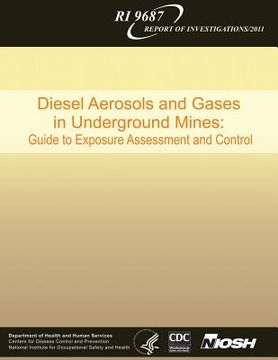Diesel Aerosols and Gases in Underground Mines: Guide to Exposure Assessment and Control (en Inglés)
Reseña del libro "Diesel Aerosols and Gases in Underground Mines: Guide to Exposure Assessment and Control (en Inglés)"
Diesel engines are a major contributor to concentrations of submicron aerosols, CO, CO2, NOX, SO2 and hydrocarbons (HC) in underground coal and metal/nonmetal mines. The extensive use of diesel-powered equipment in underground mines makes it challenging to control workers' exposure to submicron aerosols and noxious gases emitted by those engines. In order to protect workers, mines need to establish a comprehensive program based on a multifaceted and integrated approach. This program should include a concerted effort to: Curtail emissions of the diesel particulate matter (DPM) and toxic gases at the source; Control pollutants after they are released in the underground mine environment; and Use administrative controls to reduce exposures of underground miners to pollutants. Many of the technologies and strategies available to the coal and metal/nonmetal underground mining industries to control exposures of underground miners to diesel pollutants are similar. However, the differences in the U.S. regulations limiting DPM exposures of miners in underground underground coal mines [66 Fed. Reg. 27864 (2001)] and metal/nonmetal mines [71 Fed. Reg. 28924 (2006)] have a major bearing on how those technologies and strategies are implemented. In underground coal mines, achieving compliance is based on implementing technologies developed to control DPM and gaseous emissions directly at their source and providing sufficient quantities of fresh air to dilute criteria gases emitted by diesel engines [61 Fed. Reg. 55411 (1996)]. In contrast, the metal/nonmetal performance-based regulations enforce personal exposure limits (PEL) and provide much more latitude in the selection of technologies and strategies to control miners' exposures to DPM and gases [MSHA 2008]. The effort to reduce the exposure of underground miners to diesel pollutants requires the involvement of several key departments of mining companies, including those responsible for health and safety, engine/vehicle/exhaust aftertreatment maintenance, mine ventilation, and production, as well as the departments responsible for acquiring vehicles, engines, exhaust aftertreatment systems, fuel, and lubricating oil. Due to the complexity of this problem and the involvement of personnel from various departments in an underground mine, a program coordinator is crucial to the success of diesel control programs. The diesel pollutants control program plan and execution of this plan should be dynamic and based on information gathered through surveillance efforts. This surveillance should include gathering information on parameters pertinent to planning, execution, and coordination of the program (e.g., size of the diesel-powered fleet, role of diesel-powered equipment in the mining process, type of engine emissions, contribution of diesel-powered equipment to exposure of underground miners to DPM and criteria gases, quality of diesel fuel and lubricating oil, and ventilation supply and demand). Surveillance efforts should also help to identify and quantify the extent of the problem, identify and evaluate potential solutions, and identify and establish a hierarchy of potential solutions. The adopted solutions should be instituted and implemented in a manner that takes the costs and benefits into consideration. The surveillance efforts should be continued throughout the implementation phase of the program, and the results should be used to constantly re-evaluate the effectiveness of the program and adjust actions accordingly. Establishing a hierarchy of solutions is critical to the success of a multifaceted diesel pollutants control program.

